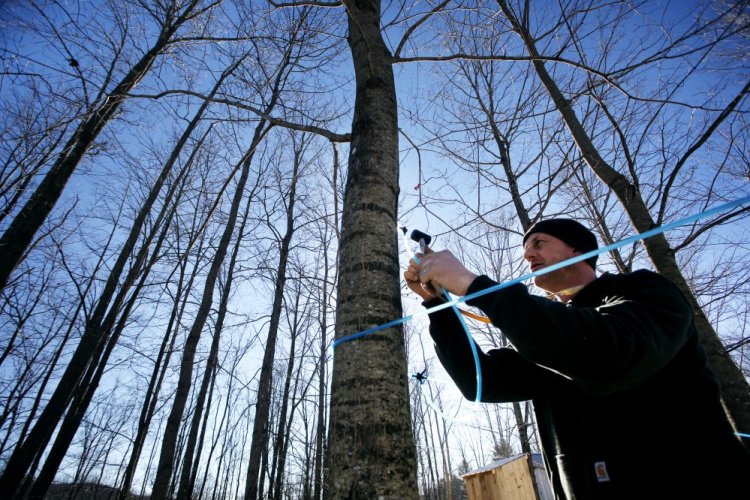MONTPELIER, Vt. – With the U.S. maple syrup season wrapping up, Vermont producers are expecting yields approaching last year’s record even after they contended with fluctuating weather.
Vermont is the country’s leading maple syrup state, producing a record 1.9 million gallons of syrup last year.
Vermont maple specialist Henry Marckres said Monday that producers who tapped early to take advantage of unusual warmups during January and February had an average season, while overall production in the state was strong because of an increase in the number of taps.
There were between 500,000 to 750,000 more taps used in Vermont this season for an estimated total of 6 million taps.
“Nowadays even an average season produces a lot of syrup,” said Marckres, who works for the Vermont Agency of Agriculture.
Some smaller producers who tapped trees later got about 60 percent of a crop, he said.

A large crowd lines up to visit Cooper’s Maple Products in Windham on Maine Maple Sunday in late March. Maine syrup production was average to slightly below average this season.
In Maine, syrup production was average to slightly below average because of the unfavorable weather, said Lyle Merrifield, president of the Maine Maple Producers Association. But it could’ve been worse if sugarers hadn’t taken advantage of an early gift in a freak thaw in February, when the temperature climbed to 60 degrees across the region.
About three-quarters of Maine producers took advantage of the February thaw to collect sap.
Most maple syrup producers were expecting an average season after last year’s record and kept a positive outlook.
“A lot of people are happy. When you talk to a sugar maker, every year is good, and some are better than others,” he said.
Merrifield, who has 950 taps on his farm in Gorham, said producers aren’t concerned about a shortage because of the high yield last year.
Steve Roberge, a maple specialist for the University of New Hampshire Cooperative Extension, attributed this year’s projected lower yields to “just funky weather.” He said that in southern New Hampshire, a cold snap in the traditional maple producing month of March kept sap from running for about 10 days.
Copy the Story LinkSend questions/comments to the editors.



Success. Please wait for the page to reload. If the page does not reload within 5 seconds, please refresh the page.
Enter your email and password to access comments.
Hi, to comment on stories you must . This profile is in addition to your subscription and website login.
Already have a commenting profile? .
Invalid username/password.
Please check your email to confirm and complete your registration.
Only subscribers are eligible to post comments. Please subscribe or login first for digital access. Here’s why.
Use the form below to reset your password. When you've submitted your account email, we will send an email with a reset code.